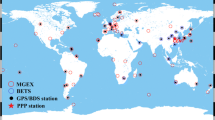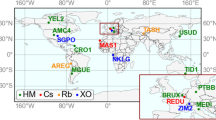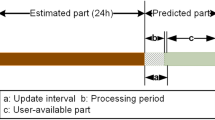Abstract
Kinematic positions of Low Earth Orbiters based on GPS tracking are frequently used as pseudo-observations for single satellite gravity field determination. Unfortunately, the accuracy of the satellite trajectory is partly limited because the receiver synchronization error has to be estimated along with the kinematic coordinates at every observation epoch. We review the requirements for GPS receiver clock modeling in Precise Point Positioning (PPP) and analyze its impact on kinematic orbit determination for the two satellites of the Gravity Recovery and Climate Experiment (GRACE) mission using both simulated and real data. We demonstrate that a piecewise linear parameterization can be used to model the ultra-stable oscillators that drive the GPS receivers on board of the GRACE satellites. Using such a continuous clock model allows position estimation even if the number of usable GPS satellites drops to three and improves the robustness of the solution with respect to outliers. Furthermore, simulations indicate a potential accuracy improvement of the satellite trajectory of at least 40 % in the radial direction and up to 7 % in the along-track and cross-track directions when a 60-s piecewise linear clock model is estimated instead of epoch-wise independent receiver clock offsets. For PPP with real GRACE data, the accuracy evaluation is hampered by the lack of a reference orbit of significantly higher accuracy. However, comparisons with a smooth reduced-dynamic orbit indicate a significant reduction of the high-frequency noise in the radial component of the kinematic orbit.











Similar content being viewed by others
References
Allan DW (1966) Statistics of atomic frequency standards. Proc IEEE 54(2):221–231
Allan DW, Barnes JA (1981) A modified Allan variance with increased oscillator characterization ability. In: Proceedings of the 35th Annual Symposium on Frequency Control, Ft Monmouth, NJ
Bertiger W, Dunn C, Harris I, Kruizinga, G, Romans L, Watkins M, Wu S (2003) Relative time and frequency alignment between two low earth orbiters, GRACE. In: Proceedings of the 2003 IEEE International Frequency Control Symposium and PDA exhibition jointly with the 17th European Frequency and Time Forum, pp 273–279
Case K, Kruizinga G, Wu S (2010) GRACE level 1B data product user handbook, vers 1.3. JPL Publication D-22027, Jet Propulsion Laboratory, Pasadena
Dow J, Neilan R, Rizos C (2009) The international GNSS service in a changing landscape of global navigation satellite systems. J Geod 83(3–4):191–198. doi:10.1007/s00190-008-0300-3
Dunn C, Kim J, Bar-Sever Y, Desai S, Haines B, Kuang D, Franklin G, Harris I, Kruizinga G, Meehan T, Nandi S, Nguyen D, Rogstad T, Thomas JB, Tien J, Romans L, Watkins M, Wu SC, Bettadpur S, Bertiger W (2003) Instrument of GRACE. GPS World 14(2):17–28
Gerlach C, Földvary L, Svehla D, Gruber T, Wermuth M, Sneeuw N, Frommknecht B, Oberndorfer H, Peters T, Rothacher M, Rummel R, Steigenberger P (2003) A CHAMP-only gravity field model from kinematic orbits using the energy integral. Geophys Res Lett 30(20):2037. doi:10.1029/2003GL018025
Jäggi A, Dach R, Montenbruck O, Hugentobler U, Bock H, Beutler G (2009) Phase center modeling for LEO GPS receiver antennas and its impact on precise orbit determination. J Geod 83(12):1145–1162. doi:10.1007/s00190-009-0333-2
Jäggi A, Bock H, Prange L, Meyer U, Beutler G (2011) GPS-only gravity field recovery with GOCE, CHAMP, and GRACE. Adv Space Res 47(6):1020–1028. doi:10.1016/j.asr.2010.11.008
Kasdin N, Walter T (1992) Discrete simulation of power law noise (for oscillator stability evaluation). In: Proceedings of the IEEE 46th International Frequency Control Symposium, pp 274–283
Kouba J (2009) A simplifed yaw-attitude model for eclipsing GPS satellites. GPS Solut 13:1–12. doi:10.1007/s10291-008-0092-1
Larson KM, Ashby N, Hackman C, Bertiger W (2007) An assessment of relativistic effects for low Earth orbiters: the GRACE satellites. Metrologia 44(6):484. doi:10.1088/0026-1394/44/6/007
Laurichesse D, Mercier F, Berthias JP, Broca P, Cerri L (2009) Integer ambiguity resolution on undifferenced GPS phase measurements and its application to PPP and satellite precise orbit determination. Navig J Inst Navig 56(2):135–149
Liu X (2008) Global gravity field recovery from satellite-to-satellite tracking data with the acceleration approach. Publications on Geodesy 68, Netherlands Geodetic Comission (NCG), Delft
Mayer-Gürr T (2008) Gravitationsfeldbestimmung aus der Analyse kurzer Bahnbögen am Beispiel der Satellitenmissionen CHAMP und GRACE. Dissertation, Univ of Bonn (in German)
Montenbruck O, Kroes R (2003) In-flight performance analysis of the CHAMP BlackJack GPS receiver. GPS Solut 7(2):74–86. doi:10.1007/s10291-003-0055-5
Montenbruck O, Garcia-Fernandez M, Yoon Y, Schön S, Jäggi A (2009) Antenna phase center calibration for precise positioning of LEO satellites. GPS Solut 13(1):23–34. doi:10.1007/s10291-008-0094-z
Montenbruck O, Steigenberger P, Schönemann E, Hauschild A, Hugentobler U, Dach R, Becker M (2011) Flight characterization of new generation GNSS satellite clocks. In: Proceedings of the 24th International Technical Meeting of the Satellite Division of the Institute of Navigation (ION GNSS 2011), pp 2959–2969
Ray J, Griffiths, J (2009) IGS Mail no. 5902: Final 30 s clock products modified. http://igscb.jpl.nasa.gov/mail/igsmail/2009/msg00028.html
Rosenband T, Hume DB, Schmidt PO et al (2008) Frequency ratio of Al + and Hg + single-ion optical clocks; Metrology at the 17th decimal place. Science 319:1808–1812. doi:10.1126/science.1154622
Schmid R, Rothacher M (2003) Estimation of elevation-dependent satellite antenna phase center variations of GPS satellites. J Geod 77(7–8):440–446. doi:10.1007/s00190-003-0339-0
Seeber G (2003) Satellite geodesy, 2nd edn. de Gruyter, Berlin New York
Senior K, Koppang P, Ray J (2003) Developing an IGS time scale. IEEE Trans Ultrason Ferroelectr Freq Control 50(6):585–593
Svehla D, Rothacher M (2003) Kinematic and reduced-dynamic precise orbit determination of low Earth orbiters. Adv Geosci 1:47–56. doi:10.5194/adgeo-1-47-2003
Tapley BD, Bettadpur S, Watkins M, Reigber C (2004) The gravity recovery and climate experiment: mission overview and early results. Geophys Res Lett 31(9):L09607. doi:10.1029/2004GL019920
Weinbach U, Schön S (2009) Evaluation of the clock stability of geodetic GPS receivers connected to an external oscillator. In: Proceedings of ION GNSS 2009, Savannah, GA, pp 3317–3328
Weinbach U, Schön S (2011) GNSS receiver clock modeling when using high-precision oscillators and its impact on PPP. Adv Space Res 47(2):229–238. doi:10.1016/j.asr.2010.06.031
Wu JT, Wu SC, Hajj GA, Bertiger WI, Lichten SM (1993) Effects of antenna orientation on GPS carrier phase. Manuscr Geod 18:91–98
Yunck TP, Wu SC, Wu JT, Thornton CL (1990) Precise tracking of remote sensing satellites with the Global Positioning System. IEEE Trans Geosci Remote Sens 28(1):108–116. doi:10.1109/36.45753
Zumberge JF, Heflin MB, Jefferson DC, Watkins MM, Webb FH (1997) Precise point positioning for the efficient and robust analysis of GPS data from large networks. J Geophys Res 102(B3):5005–5017. doi:10.1029/96JB03860
Acknowledgments
The authors would like to thank NASA and GFZ for making the GRACE data publicly available. The data and products of the IGS have been indispensable for this research. This work has been funded by the Deutsche ForschungsGemeinschaft (DFG) in the framework of the center for QUantum Engineering and Space Time research (QUEST), Hannover.
Author information
Authors and Affiliations
Corresponding author
Rights and permissions
About this article
Cite this article
Weinbach, U., Schön, S. Improved GRACE kinematic orbit determination using GPS receiver clock modeling. GPS Solut 17, 511–520 (2013). https://doi.org/10.1007/s10291-012-0297-1
Received:
Accepted:
Published:
Issue Date:
DOI: https://doi.org/10.1007/s10291-012-0297-1




